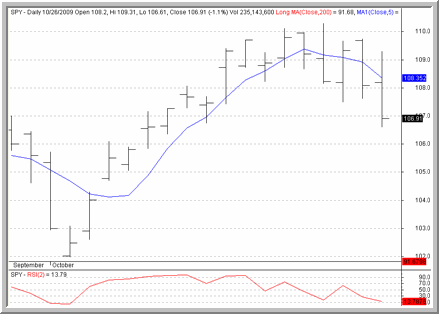High Probability ETF Trading Strategies: Multiple Days Down in SPY, EFA, XLF
Of the many high probability signals being issued in recent days as the market has pulled back, a large number of potential trades are being highlighted by a strategy I’ve discussed last week: MDU/MDD or Multiple Days Up/Multiple Days Down.
Click here to read: “High Probability ETF Trading Strategies: Up Days, Down Days, in EWY, KRE, VNQ.”
The hallmark of this strategy is that it allows high probability ETF traders to take advantage of pullbacks in ETF markets that are briefly interrupted by a one or two day counter-move.
Most of our high probability ETF trading strategies rely on increasingly oversold (or increasingly overbought for short trades) ETF markets as potential buys. This is because our research into short-term, exchange-traded fund behavior indicates that ETFs in uptrends tend to resume their uptrends after brief pullbacks. This has been the case in our simulated testing of hundreds of ETFs going back to inception (1993, in the case of the S&P 500 SPDR ETF
(
SPY |
Quote |
Chart |
News |
PowerRating).)

The S&P 500 SPDR ETF has closed lower for four out of the past five days and has a 2-period RSI of less than 14 as of the Monday’s close. SPY has an ETF PowerRating of 8.
Typically, the process of becoming increasingly oversold comes about as a result of consecutive price moves: consecutive lower lows and lower highs, or consecutively low 2-period RSIs.
However, it is also possible to buy oversold ETFs when their descent into oversold territory is uneven, with the fund bobbing and weaving a bit as it moves lower. We have quantified this behavior and fashioned it into a high probability ETF trading strategy called MDU/MDD: Multiple Days Up/Multiple Days Down, a strategy that has been correct more than 73% of the time in long trades — with an aggressive version that allows for scaling-in being accurate just over 80% of the time.

Also down for four out of the past five days is the iShares MSCI EAFE Index Fund ETF
(
EFA |
Quote |
Chart |
News |
PowerRating), which has a 2-period RSI of less than 12 and an ETF PowerRating of 8.
Included in this report are a few ETFs that have been picked up by the MDU/MDD scan of our High Probability ETF Trading Software. The High Probability ETF Trading Software is an online resource that makes it easy for traders to use the high, win-rate strategies from Larry Connors’ book High Probability ETF Trading. In addition to MDU/MDD, the High Probability ETF Trading Software includes strategies such as the 3-Day/High Low Method, the R3 Strategy and, of course, TPS — the strategy used to trade ETFs in Larry Connors’ daily trading advisory service, the Daily Battle Plan.

Also with an ETF PowerRating of 8, the Financial Select Sector SPDR ETF
(
XLF |
Quote |
Chart |
News |
PowerRating) has closed for five out of the past seven trading days. As of the Monday’s close, XLF has a 2-period RSI of less than 18.
High Probability ETF Trading Software puts 7 high, win-rate ETF trading strategies at your fingertips, with entry, exit and scale-in alerts so that traders know exactly where they are in the strategy they are trading. With the guesswork removed, traders using High Probability ETF Trading Software can focus on the real work of managing the trade.
Won’t you give our High Probability ETF Trading Software a try? With the markets pulling back in recent days, the next round of high probability trading signals may be only days away. Click here to launch your free, 14-day trial to High Probability ETF Trading Software today!
David Penn is Editor in Chief at TradingMarkets.com.
